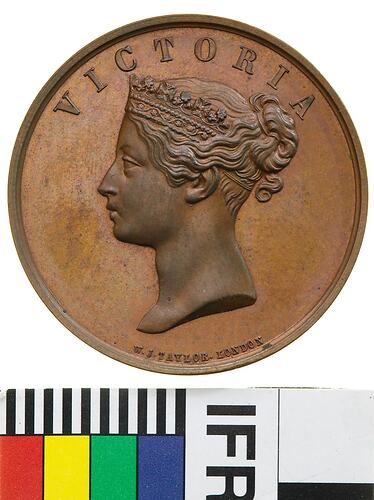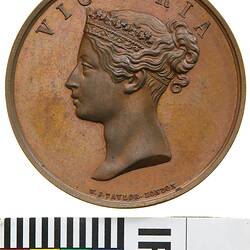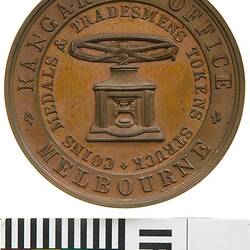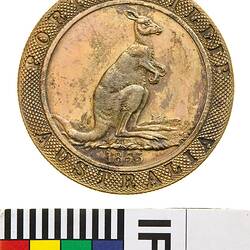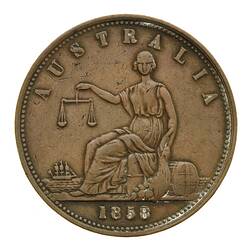Summary
Bronze Medal, minted by W.J. Taylor of London, circa 1853. The medal was used to promote the newly opened Kangaroo Office, in Melbourne, Victoria.
W. J. Taylor and his business partners established the Kangaroo Office to take advantage of the explosive economic growth in Australia following the discovery of gold in 1851. They hoped to buy gold at greatly reduced prices from the gold fields and then release it at full value in the form of quarter-ounce, half-ounce, one ounce and two ounce gold coins. However due to the time required to travel between London and Melbourne, once the Kangaroo Office was ready for business in 1854, an increase in the number of British sovereigns, had seen the price of gold rise, and the potential profits for the Kangaroo Office sharply decline. Not deterred, in late 1954 Taylor prepare dies for a series of pattern copper tokens that it was hoped could be produced in Melbourne by the Kangaroo Office for circulation within Australia. It appears that this did not succeed, and in 1855 Taylor began to create shilling and sixpence patterns in silver. However the Kangaroo Office again failed to obtain authority to strike and circulate these silver tokens and in 1857 the Kangaroo Office closed.
Physical Description
A bronze medal (38 mm diameter) featuring a profile portrait of Queen Victoria and an image of the hand press sent to Melbourne on the Kangaroo.
Obverse Description
Crowned head of Queen Victoria facing left; around aboive, VICTORIA; below in small letters the mint details, W.J. TAYLOR. LONDON
Reverse Description
At centre a view of the hand opperated screw-press of the Kangaroo Office, around inside a broad rim, COINS MEDALS AND TRADESMEN'S TOKENS STRUCK; around all on broad rim, KANGAROO OFFICE * MELBOURNE *
Edge Description
Plain
Significance
On October 26 1853 William Joseph Taylor arrived in Melbourne on the 'Kangaroo' with a large coining press. Taylor was a Birmingham engraver and die-sinker, and an enthusiastic entrepreneur. The primary purpose of the voyage of the 'Kangaroo', chartered by Taylor, and two associates, Hodgkin and Tyndall, was probably to import merchandise which was to be sold from the Franklin Street West office. The enterprise was a disaster, however: by the time the goods were offloaded there was an over-supply of goods in the Colony, and the anticipated returns were not realized. Taylor's private mint was eventually set up some eight months later, around July 1854, pressing trade tokens until the Melbourne Exhibition opened in October. It was then mainly used for agricultural medals until it was sold to Thomas Stokes in 1857. See Parties Module (Kangaroo Office) for further information. -Sharples, John. 1988. 'The Kangaroo Office': A Nineteenth Century 'Sting'. NAA Journal. 4: 29-37; McDonald, Greg. 1992. Collecting and Investing in Australian Coins and Bank Notes. -D. Tout-Smith 8/10/2003.
More Information
-
Collecting Areas
-
Acquisition Information
Transfer from National Gallery of Victoria (NGV), 15 Mar 1976
-
Date Issued
circa 1853 AD
-
Issued By
Kangaroo Office (Mint), Melbourne, Greater Melbourne, Victoria, Australia
-
Mint
-
Commissioned By
Kangaroo Office (Mint), Melbourne, Greater Melbourne, Victoria, Australia, circa 1853
-
Inscriptions
Obverse: VICTORIA W.J. TAYLOR. LONDON Reverse: KANGAROO OFFICE MELBOURNE COINS MEDALS AND TRADESMEN'S TOKENS STRUCK
-
Series
-
Material
Bronze
-
Axis
12
-
Classification
-
Category
-
Discipline
-
Type of item
-
Dimensions
38 mm (Outside Diameter), 26.723 g (Weight)
-
Shape
Round
-
References
And.784
[Book] McDonald, Greg. 1991. Collecting and Investing in Australian Coins and Bank Notes.
[Article] Sharples, John. 1988. 'The Kangaroo Office': A Nineteenth Century 'Sting'. Journal of the Numismatic Association of Australia. 4: 29-37.
-
Keywords
Australian Native Animals, Exhibitions: London International, Great Exhibition, 1851, Exhibitions: Melbourne, 1854
